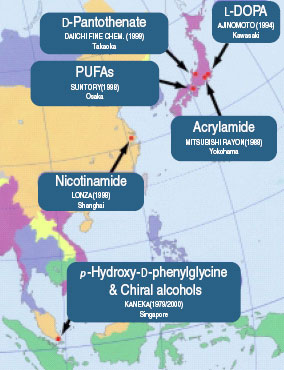Discovering and developing the unique functions of microorganismsand creating industrial applications for them
- How microorganisms assist us in our daily lives -
Japan, a country rich in microbial resources
It is often said that Japan is a country with few natural resources. But you may be surprised to learn that when it comes to microorganisms Japan is one of the most resource rich countries in the world. It is estimated that a single gram of soil contains between 10 million and 100 million microorganisms. Japan is extremely varied geographically, hence an extremely wide variety of microorganisms can be found here. What's more, these microorganisms undergo variations throughout the year as the seasons change. It is considered highly likely that just by looking for them we will be able to discover microorganisms with superior capabilities or previously unknown abilities. The richness of our microbial resources is one of the reasons why in the field of applied microbiology, Japan is today one of the most advanced countries in the world.
At the Laboratory of Fermentation Physiology and Applied Microbiology "Hakko (fermentation) lab" here at Kyoto University we are working to discover and develop the latent possibilities of microorganisms. The aim of our research is to turn these possibilities into useful applications.
The Kyoto University "Hakko lab" processes, which were developed through collaboration with industries, are now used all over the world. They are called as microbial factories (see the map below).
1. Using microorganisms to produce edible oil
Until recently no one realized that microorganisms are a promising source for abundant quantities of polyunsaturated fatty acids (PUFAs), which are used in medicines and functional food products. At the Faculty of Agriculture here at Kyoto University we discovered that a filamentous fungus, which we isolated from among the microorganisms found in earth taken from the campus, produces prodigious quantities of oils containing arachidonic acid. With this discovery as a starting point, we conducted research employing methods from metabolic engineering and molecular biology for controlling cultures and breeding mutant strains. Finally, we achieved the ability to produce a variety of PUFAs containing selected oils in large quantities. We call these unique oils produced by microorganisms "fermentation oils."
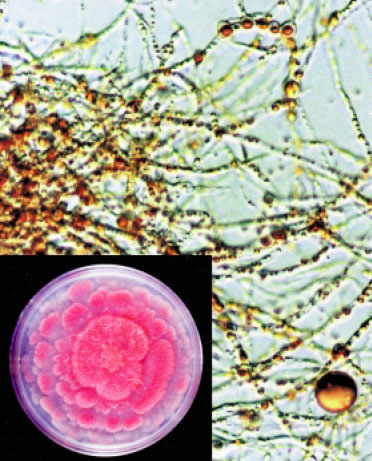
Giant colony of Mortierella alpina on agar plate containing tetrazolium salt (lower left). Oil drops of polyunsaturated fatty acids accumulated in the mycelia of Mortierella alpina.
2. Developing new tools for chiraltechnology
We are making use of the excellent stereospecificity of enzymes to develop methods for producing optically active compounds. For example, we discovered in fungus "lactonase," a new enzyme that hydrolyzes lactone rings stereoselectively. Using this reaction, we were able to develop a large-scale optical resolution method for pantolactone, a synthetic intermediate material of pantothenic acid (with a capacity of 3,000 tons per year).
3. Leading the way to green chemistry
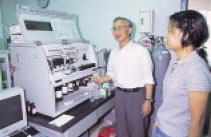
"Nitrile hydratase," an emzyme discovered by "Hakko lab", efficiently performs hydration reactions with nitrile compounds. For example, it has been used since 1988 in an industrial process (with a capacity of 30,000 tons per year) for producing acrylamide from acrylonitrile. This marked the first example of the use of a biocatalyst in the production of commodity chemicals. It has been the subject of a great deal of attention worldwide as a successful example of environmentally friendly green chemistry.
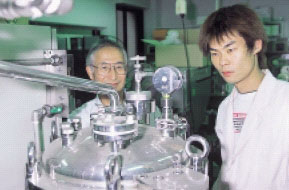
Prof. Shimizu providing guidance in the lab. The overall research field of "Hakko lab" is broad-from molecular biology to fermentation physiology, so research activities are divided between several rooms. It is difficult that all members of the lab get together in the same place.

 , the stone monunent for microorganisms who gave their lives as research specimens. It was constructed in the precincts of the Manshuin temple in north portion of the city of Kyoto.
, the stone monunent for microorganisms who gave their lives as research specimens. It was constructed in the precincts of the Manshuin temple in north portion of the city of Kyoto.
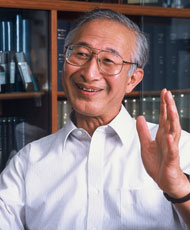
Sakayu Shimizu
Born in 1945.
Graduate of the doctoral program, Graduate School of Agriculture, Kyoto University
Ph.D., Kyoto University
Professor, Graduate School of Agriculture, Kyoto University
URL Lab Applied Microbiology (Kyoto Univ) (External Link)
"Our laboratory has a will of its own. Perhaps this more than anything else sets us apart from other labs."
"Hakko lab" has a tradition of performing research even in fields somewhat removed from its area of specialization if they are "useful and interesting." It is known popularly as the "sesame lab" because it was here that the unique properties of sesame oil were accidentally discovered in the process of tests on the use of microorganisms in the production of fermentation oils. The "open sesame" that opened the doors of our sesame research was provided by sesamin, a substance present sesame seeds in minute quantities. There are already products on the market in which sesamin is used as a food supplement for its healthful properties. Prof. Shimizu says that the ultimate goal of the lab's work is to produce results that will contribute to people's lives. As a result, the lab has a long history of collaboration with industry. Though nowadays global standards hold sway, one can glimpse in the gentle face of Prof. Shimizu, who feels that one's own traditions and ways of doing things should be the basis for one's values, something of the spirit of a craftsman who refuses to be distracted by passing fads.

In the lab can be seen a framed motto in Chinese characters:  . It is a quotation from the I Ching, the Confucian Book of Changes, meaning "Continue to work hard and you will receive your reward without fail." The students who work in the lab inherit a certain perspective on human philosophy through their research work.
. It is a quotation from the I Ching, the Confucian Book of Changes, meaning "Continue to work hard and you will receive your reward without fail." The students who work in the lab inherit a certain perspective on human philosophy through their research work.


